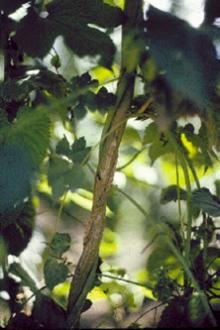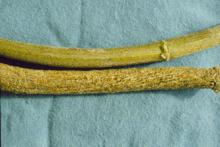By C. M. Ocamb and D. H. Gent
Cause Soil residues of heptachlor epoxide, a chemical associated with past application of heptachlor and chlordane. Heptachlor epoxide residues slowly degrade, so the problem ultimately will disappear but there are anecdotal reports of damage in yards that were treated 50 years earlier. Current soil concentrations of heptachlor epoxide usually are lower than the sensitivity of the most accurate detection methods (less than 10 ppb), but some hop varieties remain sensitive even at these low levels.
Symptoms The bine's central pith looks water soaked. Also, the bine epidermis looks rough and corky, particularly at the soil line and extending up the bine. The epidermis cracks and oozes plant sap. The crown may show extensive necrotic areas of blackened and rotted tissue, especially those portions over 1 year old. Bine growth is stunted and may be wilted, and affected yards show sparse bine growth and foliage.
Cultural control
- Avoiding contaminated fields is the best practice; however, damaging levels of heptachlor epoxide may persist in soils for an extremely long time.
- Tolerant varieties generally can be grown without concern for heptachlor epoxide soil residue. The most tolerant varieties are 'Cluster', 'Olympic', 'Chinook', and 'Bullion'. The varieties, 'Galena' and 'Cascade' are intermediate. Sensitive varieties include 'Willamette', 'Mt. Hood', 'Liberty', 'Fuggle', and 'Nugget'.


